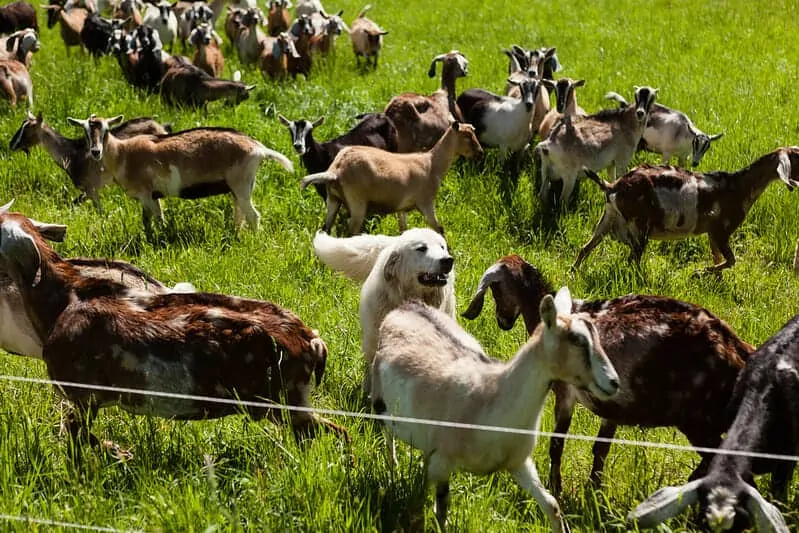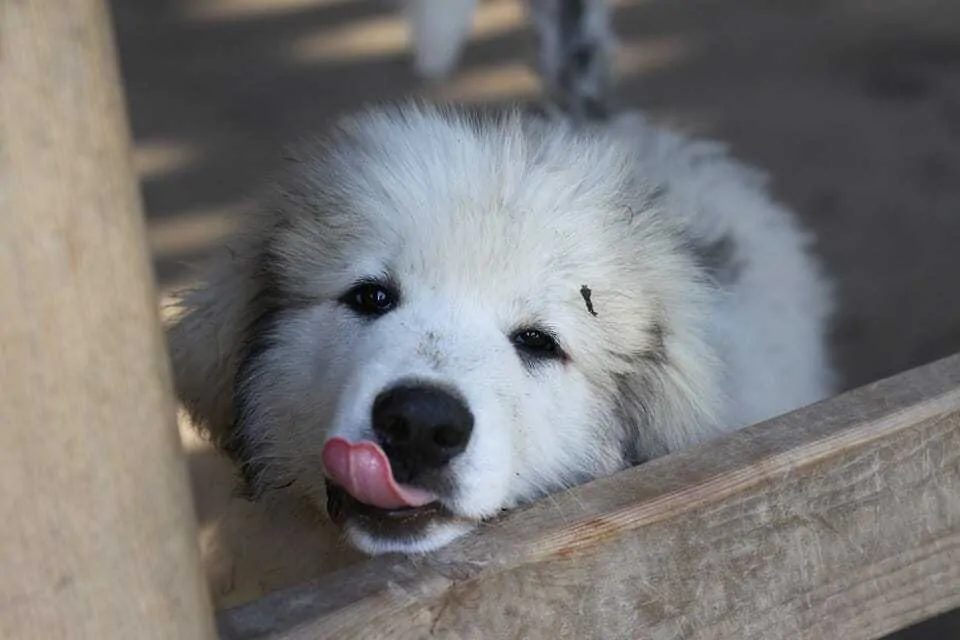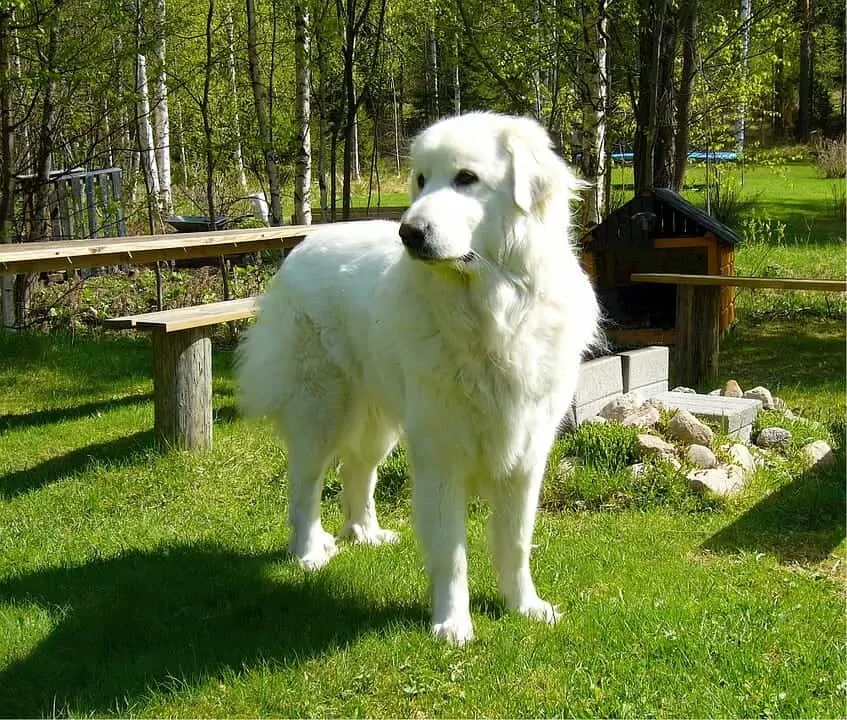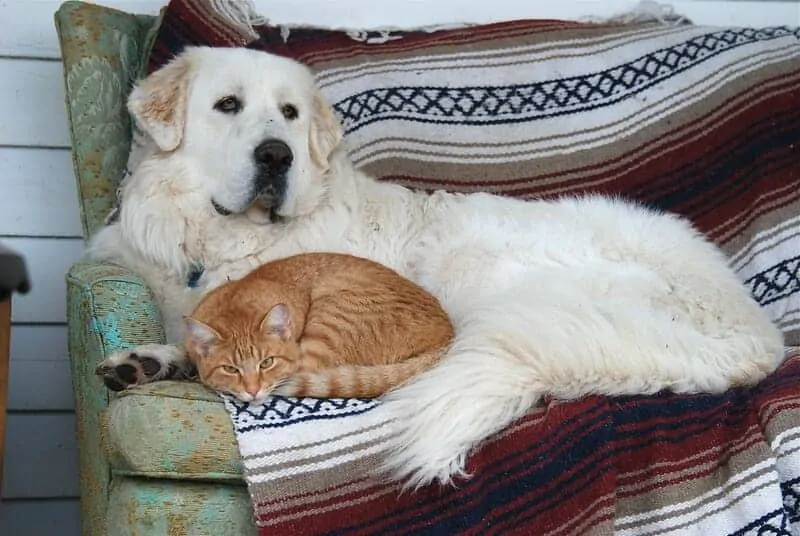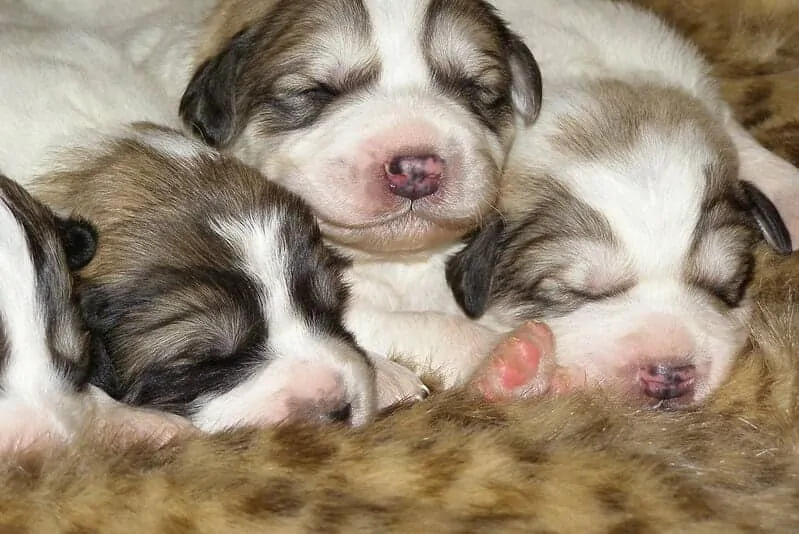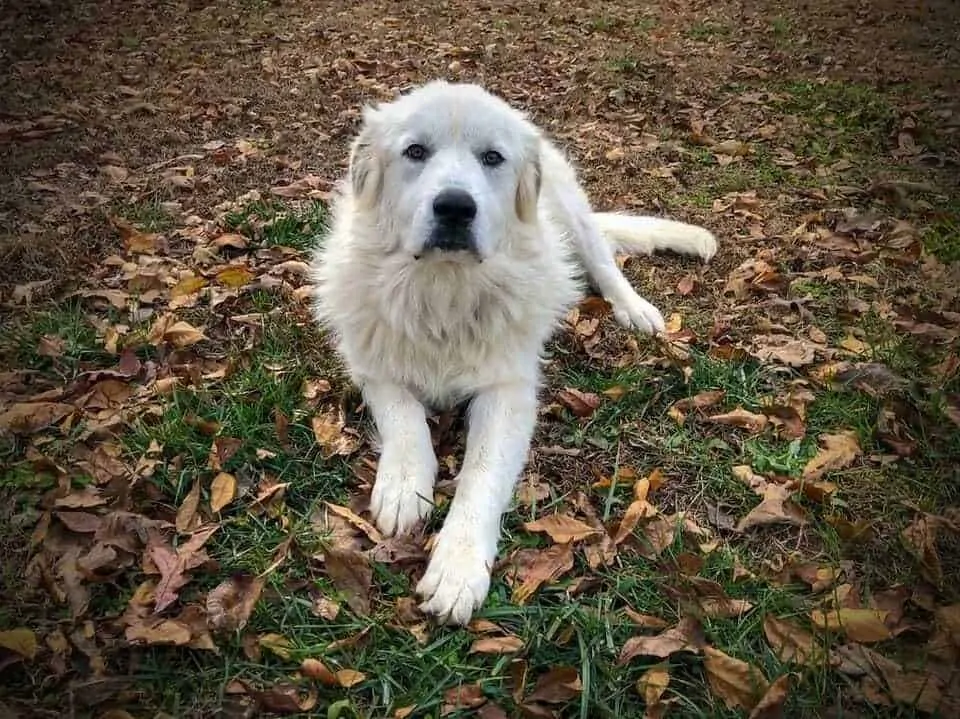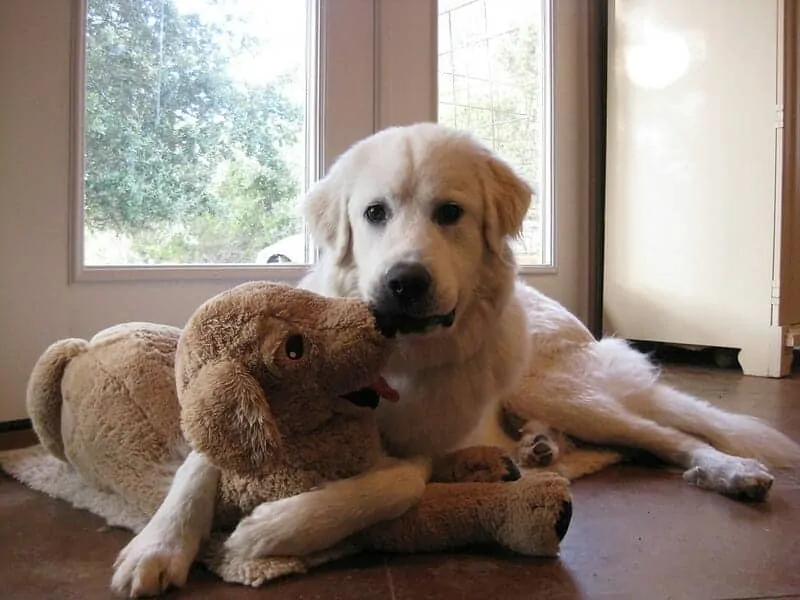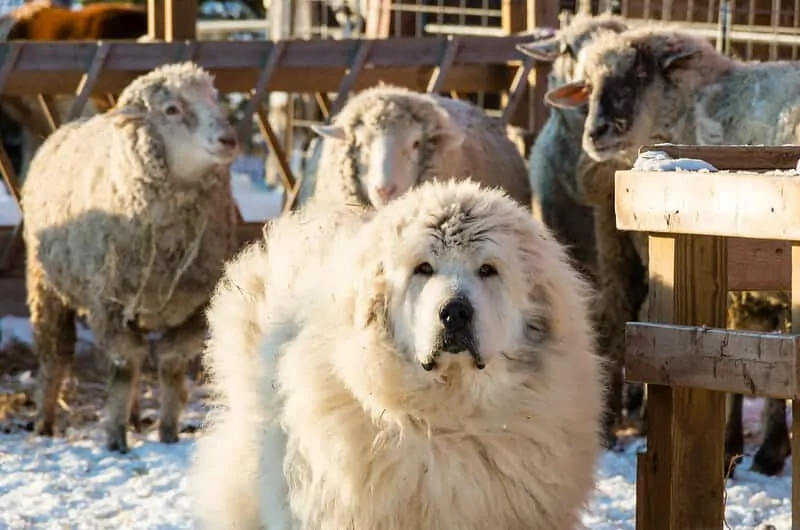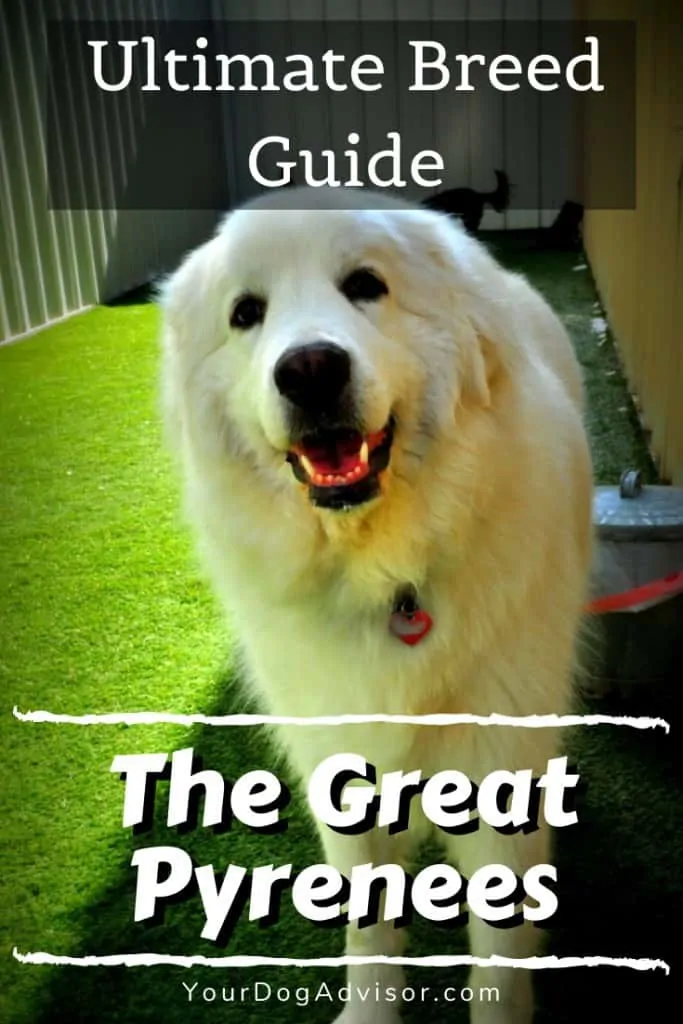The great white mountain dog from the Pyrenees isn’t like many other canines you’re likely to find. Their steadfast poise and undying loyalty make them perfect as livestock guardians and as gentle family pets.
But these dogs are also very independent and a bit aloof and require a lot of socialization when they are young in order to grow into well-rounded canine companions. Not every owner has what it takes to mold the wild GP into a house pet, but those who do are rewarded with a dog that is as loveable as it is beautiful.
Keep reading to learn more about the majestic ghost of the Spanish mountains and to find out if this unique breed is right for you.
Contents
General Characteristics of the Great Pyrenees
- Other names: Pyrenean Mountain Dog
- Height: 25 to 32 inches
- Weight: 85 to over 100 pounds
- Lifespan: 10 to 12 years
- Origin: Great Pyrenees mountains between France and Spain
- Colors: White, white with tan, gray, or cream patches
- Activity level: Moderate
- Grooming needs: Moderate to high
- Best suited for: Families experienced with independent breeds
Great Pyrenees are happiest when they are part of a herd, whether that’s a herd of goats, sheep, or their human family. While these dogs can make great companion dogs, their history as a working breed comes with its own set of challenges. “Small farm in Otsego County, N.Y.” by Chesapeake Bay Program / CC BY-NC 2.0
The History of the Great Pyrenees
The GP is an ancient livestock guardian breed that has been used for centuries in the Pyrenees mountains between Spain and France. Shepherds and cattlemen preferred a dog that was agile enough to navigate the rugged terrain but also large enough to defend the herd against wolves, bears, and thieves. Those born with predominantly white coats were also favored as they were easier to see against the landscape and wouldn’t be confused with predators even in dim light.
While these dogs have always been loyal companions, their main job was to live and travel with the herd as they grazed in the high country. Like all guardian breeds, much of this behavior is instinctual. Still, young Pyrs depend on the guidance of their parents and other adult guardian dogs to learn the finer aspects of the job. Historically, other than providing the right environment for learning, owners of these dogs did little in the way of training.
The first Pyrenees came to the United States in 1824 but the breed was not recognized by the AKC until the 1930s. At that time, a deliberate and well-organized breeding program brought 10 GP bloodlines from Europe. Their popularity has grown since that time, both as a working dog and as a companion animal.
More recently, Pyrs and other livestock guardian dogs, such as the Akbash, have been gaining popularity in Africa. Their unshakable bravery and fierce loyalty to their flock make them an excellent choice to guard goat herds against cheetahs and other large African predators.
Check out this video to see the great Pyrenees performing their original duty as livestock guardians.
The Temperament of the Great Pyrenees
Like many livestock guardians, the Pyr is known to be somewhat aloof with strangers and incredibly independent. But unlike many similar breeds, the fierceness of the GP seems to be reserved for animal predators and rarely will a Pyr do more than bark at human trespassers. This trait makes these dogs more accessible to the average family than others in the same class.
Still, this dog comes from a long line of canines who spent most of their lives making their own decisions while wandering freely around the mountains. While they learn very quickly by watching other dogs, they don’t often care to listen to their human counterparts. This feature of the GP personality is sometimes interpreted as a lack of intelligence, when, in fact, these dogs are incredibly sharp, they just prefer to do things on their own terms.
Despite their stubborn nature, these canines have a reputation for being excellent family dogs, and for good reason. The same instincts that make these dogs perfect for caring for newborn lambs also make them gentle and tolerant siblings.
This gentleness is easily seen when these dogs are indoors. Most mature Pyrs prefer to spend their days lounging about on the couch or sprawled across the floor. But outdoors, these dogs enjoy their space and like to explore. Without a large area to roam or frequent walks, they will get bored, which can lead to destruction and other naughty habits.
Traditionally, GP puppies are kept with the flock from a very young age so they can learn to see the sheep as part of their family.
Health Issues Common to the Great Pyrenees Breed
Steadfast dedication to the breed from their introduction into the US and the availability of multiple ancient lines in Europe means that the GP is overall a very healthy dog. But, like all large dogs, they are prone to joint and eye diseases, as well as various other illnesses that prospective owners should be aware of before committing to owning a GP.
The most common health issues affecting the great Pyrenees are:
- Hip dysplasia
- Elbow dysplasia
- Panosteitis
- Patellar luxation
- Osteochondrosis Dissecans
- Entropion
- Cataracts
- Skin problems
- Certain cancers
Like many large dogs, GPs are especially susceptible to a very dangerous condition called bloat. When excess gas gets trapped in the stomach, it can cause the internal organs to twist, cutting off circulation to the tissues and making it difficult for the dog to breathe. This is a life-threatening condition that can kill an otherwise healthy dog in a matter of hours.
Dogs experiencing bloat will show initial signs such as panting and stress, unproductive vomiting, frequently looking back at their stomachs, restlessness, and a painful abdomen. As the problem advances, the dog may suddenly become lethargic, be unable to stand, or lose consciousness. If you suspect bloat, it is important that you get your dog to a vet right away as this condition will not correct itself.
Like many ancient dog lines, the Pyr is a relatively healthy breed, but searching out a responsible breeder is still a good idea to make sure you get a puppy that is free from genetic disease and has the right temperament to be a companion dog.
To reduce your great Pyrenees’ odds of bloat, make sure to never feed them from a raised dish or to feed them too large a portion at a time. All dogs should be given at least an hour after eating to digest before doing anything active like going for a jog or playing fetch in the yard.
If you plan to purchase your new Pyr pup from a breeder, make sure to do your homework and only approach breeders with a positive reputation who are willing to show you the health records of both parents and let you see where the puppies will be whelped. Responsible breeders with a goal of producing healthy, vibrant GPs shouldn’t hesitate to provide this to prospective buyers.
There are also a number of great Pyrenees rescues that have Pyr pups and adults available for adoption.
Do Great Pyrenees Do Well With Children and Other Pets?
Despite their large size and reputation for chasing down wolves and bears, the Pyr is at its heart a dog that thrives within a family. These great whites have a gentle nature that makes them a natural choice for owners with small children. Their laid back nature means they tend to be incredibly tolerant.
Of course, all animal-child interactions should be supervised. But if your hope is to find a dog that you can feel confident raising your children alongside, this breed has one of the best chances of success.
These gentle white giants generally do well with pets of all types and sizes and are known to be one of the most tolerant breeds around. “Yoda’s Safety Blankie” by aiko vanhulsen / CC BY 2.0
In their native lands, Pyrs typically work in groups, with multiple GPs guarding the herd and other dogs, like those responsible for herding and for protecting the home, moving in and out of their lives without incident. For this reason, they tend to do well with other canine family members as long as they are introduced on neutral turf and the pecking order is well established.
In addition to making great siblings to dog and human family members, GPs tend to get along well with other pets. As long as they see the cat, bird, or ferret as part of the family, they are likely to treat it with the same loyal dedication as they do with the humans in their lives. Just be aware and move slowly when introducing new pets to the household, as anything perceived as an intruder is likely to receive a fierce welcome.
This same mentality can often lead to Pyrs taking on the role of enforcer within the family. If they believe one of their family members is in danger, they are likely to act accordingly. For instance, if another dog in the house chases the cat, expect your GP to jump to the cat’s aide and put an end to the behavior. This can also mean that rough play between children can attract unwanted attention from your GP. This “playground monitor” behavior can even extend to doggy daycares, where great Pyrenees are commonly seen rushing to the scene to put things back in order when a scuffle breaks out.
What to Consider Before Bringing Home a Great Pyrenees
Above all, the GP is a unique dog breed with a complex temperament that can be perfect for your family or a complete disaster depending on the circumstances. Before you consider adding a Pyr to your pack, here are some things worth thinking about.
GP puppies are often born with pronounced masks and patches of gray, brown, or tan. This coloring usually fades as the dog gets older and their long adult coat comes in. “Great Pyrenees Puppies” by RNCB / CC BY-NC 2.0
Activity Level
While these white giants tend to be fairly laid back in the house, they are big dogs with big brains. On top of that, they mature more slowly than most dogs and that means a prolonged adolescence filled with hijinx and questionable behavior. Young dogs will need plenty of exercise outdoors and will do well with an owner that likes to hike or take long walks.
Since GPs need extra socialization as pups to assure they don’t develop a fear of strangers or get too “guardy” against strange dogs, investing in some doggy daycare time is a good idea. As your GP ages, the need for excess activity will taper off. But, these dogs still enjoy their freedom, so some long walks in the country or time spent playing in the yard is a must. Just make sure your Pyr is always on a leash or confined since they tend to roam and aren’t known for their quick recall abilities.
Trainability
Like their mountain breed brethren, GPs are independent and stubborn. To make things worse, most aren’t overly food motivated and their goal in life is not to please you. If you want to find success in teaching your Pyr some obedience, you’ll have to get creative and be patient. Your dog will likely learn what you are teaching them fairly quickly, but they are only likely to comply if it suits them.
At the same time, these dogs tend to be sensitive and an overdominant owner or one who resorts to punishment is likely to end up with a dog that’s even less apt to listen and more closed off. Using a well-trained, older dog as an example for your young Pyr to learn from is often the best way to shape their behavior.
Don’t let those big brown eyes fool you, Pyrs are not known for wanting to please their people. While they are generally sweet, gentle dogs, they are very independent and don’t always listen to commands, even if they know them.
Grooming
Great Pyrenees have long, double coats that shed all year long. And their white color can mean frequent baths are a must, despite the fact that their coats repel water and filth better than the average dogs’.
Be prepared to brush your dog weekly and pay for the occasional trip to the groomers. The extraordinary coat of a GP will keep your dog cool in summer and warm in winter, but only so long as the dead hair is removed as it falls out. Never shave your GP as this will render the coat useless and make it difficult for your dog to maintain the right temperature even after the hair grows back. Although, a sanitary trim and some light feather trimming may be necessary to keep your dog looking their best.
Your GP will also need their nails trimmed frequently, especially those back dewclaws.
Nutrition
GPs are selective eaters and not known for overindulging. Make sure to choose a food with plenty of quality fats and lots of protein from animal sources. Not only will the fat help pique their appetite, but the combination of fat and protein will nourish their coat while keeping their bones and joints healthy.
While most Pyrs will prefer to graze throughout the day, it is best to offer two or three meals and pick up the bowl in between. This will help build better eating habits and reduce the odds of bloat caused by excess activity right after eating.
While males may reach 100lbs before their first birthday, GPs have extended adolescence and aren’t mentally mature until closer to three or four years of age. “Bix” by Wablair / CC BY 2.0
Cost
On average, purebred Pyrs cost over $500 with show quality and breeding stock fetching closer to $5,000. Rescues charge substantially less for adoptable Pyrs, but you should still expect to pay a few hundred in adoption fees.
These are large dogs and, in addition to typical vet bills, they will cost a lot to feed. You should also be prepared to pay a premium for grooming every couple of months. It’s also wise to invest in puppy obedience classes, doggy daycare, and other dog-related activities to help socialize your GP when they are young.
>>>Find out the true annual cost of owning a dog.
10 Fun Facts About the Great Pyrenees
Now that you know what it takes to own a GP, here are ten lesser-known facts about this ghost dog from the Spanish peaks.
- GPs have a double dewclaw on their rear legs. This trait helped their ancestors gain traction on the rugged mountain slopes.
- Remains of Pyrenees dogs have been found as far back as 1800 BC.
- It is believed that the GP breed descended from ancient livestock guardians that traveled with nomads across China and Siberia.
- Prior to breed standardization, the GPs traditionally found on the west and east side of the Pyrenees mountains were strikingly different in appearance.
GPs are a hardy breed that was tailored to tolerate the harsh high altitude environment of the Pyrenees mountains. Despite their docile disposition, these dogs were bred to work. “Badger the Great Pyrenees Guarding the Sheep, Iowa” by Alexandra Stevenson / CC BY-ND 2.0
- GPs are used all over the world as flock guardians, including Africa and Australia.
- Pyrs were likely part of the mix of dogs that went into creating the Leonberger.
- Most GP pups have dark patches and masks that fade as they grow older.
- GPs were considered royalty in France.
- Like many guard dogs, Pyrs tend to be more active at night than during the day.
- The GP was used to revive the St. Bernard breed after the genetic pool fell too low to breed back in Switzerland.
Before You Go
Not sure the great Pyrenees is the right dog for your family? Check out these Ultimate Breed Information Guides:
- Great Swiss Mountain Dog
- Tibetan Mastiff
- Labrador
- Rhodesian Ridgeback
- Rough Collie
- Hypoallergenic Dog Breeds

Sara Seitz has spent most of her life in the pet industry and has a bachelors in animal behavior from Colorado State University. Sara started working with dogs and cats as a high schooler at a rural boarding kennel. There she learned a lot about the bad and the ugly of the pet service industry. But not even the toughest day at that job would dissuade Sara from following her dream of working with animals.
In college, Sara got a job at a dog daycare and boarding facility in Fort Collins, Colorado. Her new career provided even more opportunities for learning about dog behavior than her classes did. As general manager of the daycare, Sara helped the company launch a new in-home pet sitting branch and trained to become a certified dog trainer. Between shifts taking care of peoples pets in-home and supervising dogs during playtime at the daycare, Sara organized and taught obedience classes.
Sara has always been passionate about bettering the lives of our canine companions. She soon found that advocating for and educating owners in the power of positive reinforcement training was one of the best ways to help dogs and their owners live happier lives.
